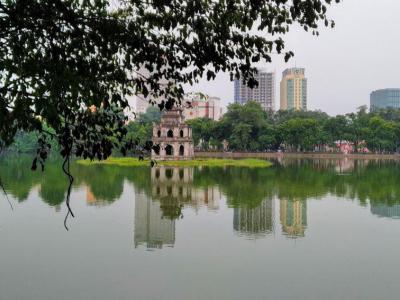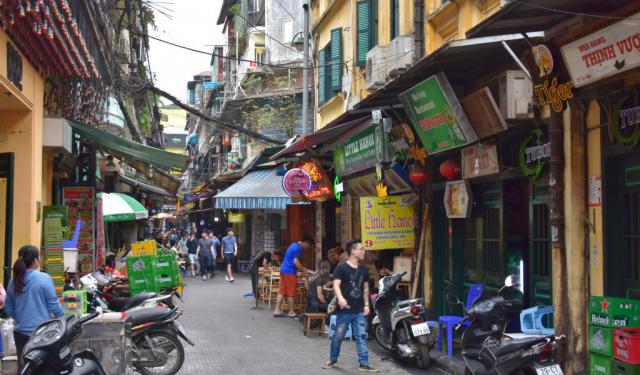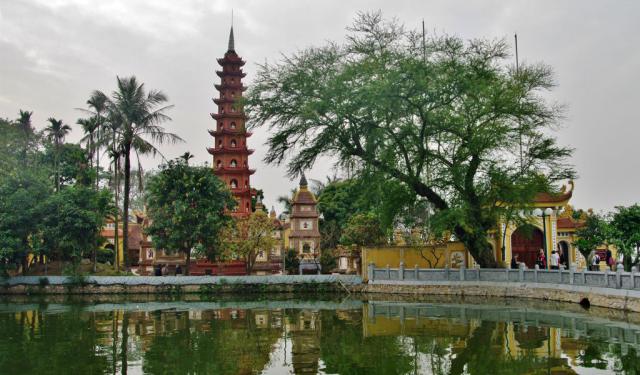Hoàn Kiếm Lake, Hanoi (must see)
Hoàn Kiếm Lake holds a storied place at the heart of Hanoi. Also known as Sword Lake, this 12-hectare freshwater lake is a central feature of the city's public and historical life. Located in Hanoi's historical center, the lake is not only a major scenic spot but also a focal point for the city's public life, surrounded by vibrant streets and bustling local markets.
Originally named Green Water Lake (Hồ Lục Thủy) for its distinctive watercolor, the lake's present name, which means "Lake of the Returned Sword," is derived from a legendary event. The tale recounts that Emperor Lê Lợi, after defeating Ming China, was approached by a Golden Turtle God (Kim Qui) while boating on the lake. The turtle god requested the return of a magical sword, Heaven's Will, given to Lợi by the Dragon King (Long Vương) to aid in his battle against the Chinese. Acknowledging that his mission was accomplished, Lợi returned the sword to the turtle. This pivotal event led to the renaming of the lake to commemorate the sword's return.
The Turtle Tower (Tháp Rùa), situated on a small island near the center of the lake, is a prominent landmark associated with this legend. It stands as a silent reminder of the lake's mythological past. The lake was once home to the large soft-shell turtle species Rafetus leloi, named in honor of the emperor. Although the last known specimen was found deceased in 2016, the species remains emblematic of the lake's rich biodiversity.
To the north, the Jade Islet is connected to the lake's shore by the striking vermilion-red Thê Húc Bridge, which means "Perch of the Morning Sunlight". Atop the islet sits the Temple of the Jade Mountain (Ngoc Son), erected in the 18th century. This temple honors notable historical figures such as Tran Hung Dao, a military leader known for his victories over Mongol invaders; Van Xuong, a revered scholar; and Nguyen Van Sieu, a renowned writer who refurbished the temple in 1864, lending it its current appearance.
Today, Hoàn Kiếm Lake remains a vital part of Hanoi’s cultural fabric, attracting visitors with its serene beauty and rich history, encapsulating a blend of natural charm and cultural significance.
Originally named Green Water Lake (Hồ Lục Thủy) for its distinctive watercolor, the lake's present name, which means "Lake of the Returned Sword," is derived from a legendary event. The tale recounts that Emperor Lê Lợi, after defeating Ming China, was approached by a Golden Turtle God (Kim Qui) while boating on the lake. The turtle god requested the return of a magical sword, Heaven's Will, given to Lợi by the Dragon King (Long Vương) to aid in his battle against the Chinese. Acknowledging that his mission was accomplished, Lợi returned the sword to the turtle. This pivotal event led to the renaming of the lake to commemorate the sword's return.
The Turtle Tower (Tháp Rùa), situated on a small island near the center of the lake, is a prominent landmark associated with this legend. It stands as a silent reminder of the lake's mythological past. The lake was once home to the large soft-shell turtle species Rafetus leloi, named in honor of the emperor. Although the last known specimen was found deceased in 2016, the species remains emblematic of the lake's rich biodiversity.
To the north, the Jade Islet is connected to the lake's shore by the striking vermilion-red Thê Húc Bridge, which means "Perch of the Morning Sunlight". Atop the islet sits the Temple of the Jade Mountain (Ngoc Son), erected in the 18th century. This temple honors notable historical figures such as Tran Hung Dao, a military leader known for his victories over Mongol invaders; Van Xuong, a revered scholar; and Nguyen Van Sieu, a renowned writer who refurbished the temple in 1864, lending it its current appearance.
Today, Hoàn Kiếm Lake remains a vital part of Hanoi’s cultural fabric, attracting visitors with its serene beauty and rich history, encapsulating a blend of natural charm and cultural significance.
Want to visit this sight? Check out these Self-Guided Walking Tours in Hanoi. Alternatively, you can download the mobile app "GPSmyCity: Walks in 1K+ Cities" from Apple App Store or Google Play Store. The app turns your mobile device to a personal tour guide and it works offline, so no data plan is needed when traveling abroad.
Hoàn Kiếm Lake on Map
Sight Name: Hoàn Kiếm Lake
Sight Location: Hanoi, Vietnam (See walking tours in Hanoi)
Sight Type: Attraction/Landmark
Guide(s) Containing This Sight:
Sight Location: Hanoi, Vietnam (See walking tours in Hanoi)
Sight Type: Attraction/Landmark
Guide(s) Containing This Sight:
Walking Tours in Hanoi, Vietnam
Create Your Own Walk in Hanoi
Creating your own self-guided walk in Hanoi is easy and fun. Choose the city attractions that you want to see and a walk route map will be created just for you. You can even set your hotel as the start point of the walk.
Hanoi's Old Quarter Walking Tour
The Old Quarter (Vietnamese: Phố cổ Hà Nội) is the name commonly given to the historical civic urban core of the city, located outside the Imperial Citadel of Thăng Long in the northern half of Hoàn Kiếm District, renowned for its small street blocks and alleys, and a traditional Vietnamese atmosphere.
During the Lê dynasty (1428-1789), the area included several lakes and wetlands... view more
Tour Duration: 2 Hour(s)
Travel Distance: 4.0 Km or 2.5 Miles
During the Lê dynasty (1428-1789), the area included several lakes and wetlands... view more
Tour Duration: 2 Hour(s)
Travel Distance: 4.0 Km or 2.5 Miles
Hanoi Introduction Walking Tour
Known for its centuries-old architecture and rich culture with Southeast Asian, Chinese and French influences, the capital of Vietnam, Hanoi, traces its origin back to the third century BC. Originally, a portion of modern-day Hanoi served as the capital of the historic Vietnamese nation Âu Lạc. Following the collapse of Âu Lạc, the city was made part of Han China (111 BC-40 AD).
... view more
Tour Duration: 2 Hour(s)
Travel Distance: 4.0 Km or 2.5 Miles
... view more
Tour Duration: 2 Hour(s)
Travel Distance: 4.0 Km or 2.5 Miles





